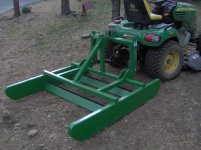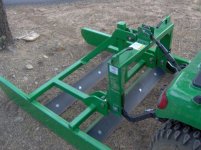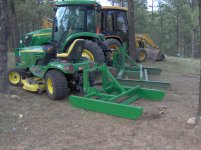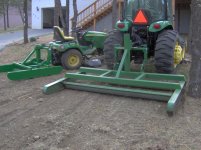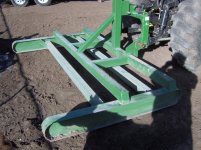Everyone will have a different way to build a lpgs, and there are many designs that will work satisfactorily. You can easily see that the two I built have different shapes and materials used to build the skids. I use my lpgs quite a lot from driveways, lawns to open fields. I have picked up a few things that help with their use and will add some changes to subsequent builds. The more you use one the more important the subtle differences make.
Of all the home built designs I have seen on TBN so far I like Gordon Gould's and my own the best. When I build another one it will combine some of the features of both Gordon's and mine. Just my opinion.
My opinion on a few points discussed in this thread, you can take them or leave them.
Skid length, short skids will work but not as well as longer skids. Motor graders have a long wheel base for a reason and the same principle applies here. There is a huge difference in how smooth you can get a driveway or field depending on how long the skids are.
Blade setting is another point of interest, if all you ever do is work a gravel driveway you could set the blades 3/4" below the skids and leave them there (fixed). This would give you slightly better mixing of the fines and larger rock. If you do fine or precision grading and packing, the blades are better set flush, this keeps you from moving material that is where it should be. Before packing the ground or driveways a lpgs with the blades 1/2" above the skids will still churn up a full load of gravel very quickly because the skids will dig in the loose materials. As you pack the surface down the skids tend to ride on the surface and you move less material. The reason I choose to set my blades flush with the bottom of the skids is simple, it works on both loose and packed surfaces without a need to adjust the height.
Grader blades are not all the same. A good quality, heavy duty blade will cost more than a soft, thin and short one. You can pick either a single edged or double edged reversible blade as long as it is mounted properly it will work. The better quality blades will last longer than the cheap thin ones, take your pick. I agree with Richard (overszd) that you should mount the blades to their support before mounting. I found that 3" angle did not have enough room to allow the plow bolts and nuts to be tucked under the edge enough to prevent wearing the nuts down, 4" angle was a better fit and is what I suggest. The plow bolts are 5/8" and require these holes to be the same size and you need enough clearance to get a socket on the back side to tighten them. Once you have the angle iron and blades made up you can choose the height you want to install them.
How far forward you set the skids is a consideration, when I built the smaller lpgs for the garden tractor I took this and the height of the limited category 1 hitch into consideration. I use a 12' trailer with a fold down tailgate to transport and made sure that it would fit inside, just enough room.
Size of the overall land plane, you don't want to struggle too much pulling it and have your tires spin. This is a finishing tool and if you spin the tires you have a hole to fill in. Better to have one you can pull a little easier and faster, you can get the same amount of work done in the same amount of time. A 54" or 60" width with long skids is what I would recommend for the 2910. With the optional tail gate similar to Gordon's design the overall weight should be in the 700 lb. range and is all you want to handle.
Here are a few pictures of the 4' and 8' land plane grader scrapers I built
